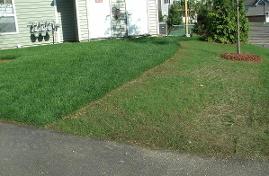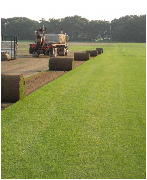
Why use turf rather than seeding?
There are many advantages to laying turf rather than seeding.
Click here to see which would be better for your circumstances.
If this link takes you to the TPI homepage, click on Consumer, then Consumer Resources/ What's best for me?
How much does 1 cubic yard of loam cover?
The following are at 25% compaction (after spreading)
| 1" | 240 sq ft |
| 2" | 120 sq ft |
| 3" | 80 sq ft |
| 4" | 64 sq ft |
| 5" | 50 sq ft |
| 6" | 40 sq ft |
807 Cubic Yards covers 1 Acre at 6"
43,560 Square Feet = 1 Acre
4,840 Square Yards = 1 Acre
1 Cubic Yard of Mulch covers 9 Square Yards
How much soil is required?
4-6 inches is good - turf will live on less soil but would require more fertilizer and watering to maintain it on a smaller soil base. Soil should be a dark loamy type. See also how to prepare the soil.
How do I lay the turf?
Lay the turf in rows that are staggered - creating a brick wall effect. Staggering encourages the seams to fill in quicker. Pieces should abut each other but not overlap or leave an opening between the pieces. A final rolling ensures that the roots will make uniform contact with the ground and squeeze out all air pockets. See also how to install sod.
How should I water the turf?
Newly installed turf needs an inch of water every day in warm weather conditions. The best way to determine an inch of water (because water pressure differs from place to place) is to put a can under the sprinkler - when there is an inch in the can there is an inch in the turf. If we are receiving natural rainfall then an inch of water every day would have to be adjusted accordingly. After the turf is established, rooting into the soils will occur with 10 - 14 days. Warm weather watering can be reduced to an inch every other day. See also how to water.
When should I fertilize my turf?
Wait at least 5 weeks from installation to fertilize the turf. After the lawn is established, a regular routine of fertilizing 4 times a year should be implemented. See also how to fertilize.
When do I water?
Begin watering turf within 30 minutes of installation. Make sure your new lawn receives 1" of water daily while it roots (usually 2 - 3 weeks). After your lawn is established, heavier, less frequent watering will encourage deeper rooting. See also how to water.
Is it possible to over-water turf?
Yes it is possible to over-water your turf. Sprinkler systems have made it much easier to over water. Signs of over watering include flattened slimy looking turf, brownness, mildew on the blades. A good watering right down to the roots followed by a period of time where the turf can dry out before the next watering is the proper way to water. Turf that is saturated with water 24 hours a day is being set up for mildew and diseases. See also how to water.
Why are there mushrooms in my lawn?
Hot, damp and humid weather encourages mushroom growth. A change in weather where we get dry air and bright sun will cause mushrooms to disappear. Over watering can also cause the correct conditions for mushrooms to grow. See also how to water.
What about grub treatments?
An application of grub control is recommended in the spring to control grub infestations. Grubs are the larval stage of certain insects that will eat turf roots. The most commonly found grub larva is the Japanese beetle grub. Beetles fly in and lay eggs from which grubs emerge to eat turf roots.
Will turf grow in the shade?
There is no turf available that will do well long term heavy shade. Turf requires a minimum of 4 hours of direct sunlight to survive. Shade causes turf to thin out and become susceptible to disease. Turf in partially shaded areas will require less water - do not allow turf to remain wet. This will result in matting and rotting grass.
Can I leave my turf on the pallet for a few days before I lay it?
No. Turf is perishable and needs to be installed as soon as possible in warm weather conditions. Classic heating patterns for turf that has been rolled up too long include yellow circular patterns in the center of each piece to completely brown individual pieces.
Other sites you might find interesting:
The Lawn Institute assists research and education for the improvement of lawns and sports turf. You can learn more about how to care for your lawn or why lawns are great for the environment.
Turfgrass Producers International tells about the benefits of grass, more aboutinstalling and maintaining sod, and has lawn care tips.
TPI - The Basic Grasses explains the differences in grass types and can help you in choosing the best grass for your lawn.

